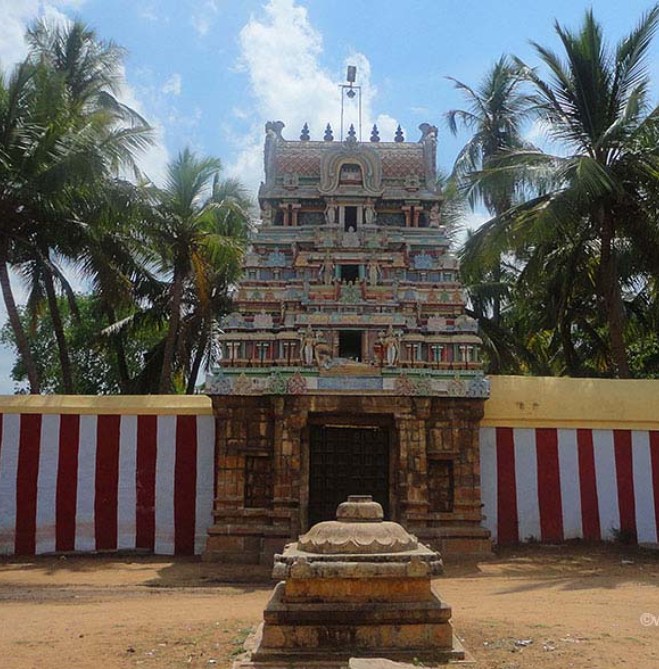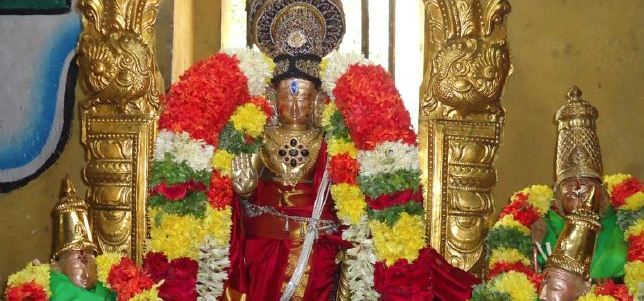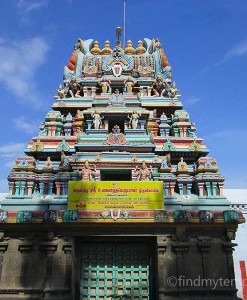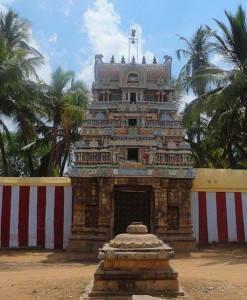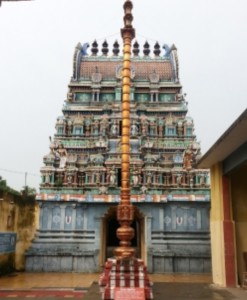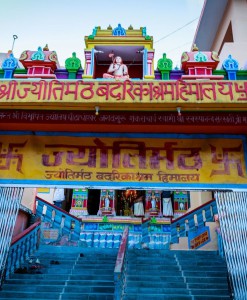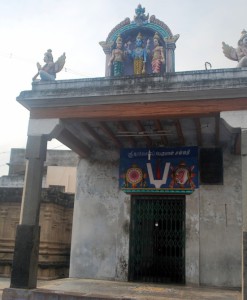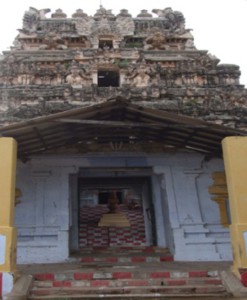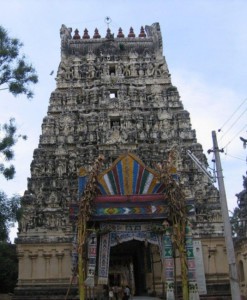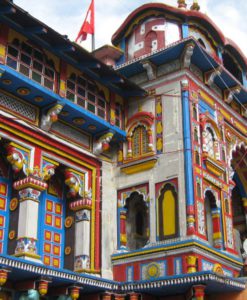No products in the cart.
Thiru Anbil, or Sundararaja Perumal Temple (also called Vadivazhagiya Nambi Perumal Temple), in Anbil, a village in the outskirts of Tiruchirappalli in the South Indian state of Tamil Nadu, is dedicated to the Hindu god Vishnu. It is one of the 108 Divyadesam dedicated to Vishnu, who is worshipped as Sundararajan and his consort Lakshmi as Sundaravalli. This temple is also known as ‘Pancha Ranga Kshetram’ of Lord Vishnu.
Architecture:
The Sundararaja Perumal Temple is believed to have been built by the Medieval Cholas of the late 8th century AD, with later contributions from Vijayanagar kings and Madurai Nayaks. The copper plate inscriptions from Anbil indicate generous contribution by the Chola kings to the temple. A granite wall surrounds the temple, enclosing all its shrines and bodies of water. The temple is located on the banks of river Kollidam. The temple is spread over an area of almost 1.5 acres of land.
The main entrance of the Sundararaja Perumal Temple faces the east and has a 3-tiered rajagopuram, the gateway tower. The main shrine has the image of the presiding deity Sundararaja Perumal in reclining posture over his divine serpant Adisesha. The images of his consorts, Sridevi and Bhoodevi, Brahma are present in the sanctum. The festive image of Sundararajan, Vadivazhagiya Nambi, is housed in the sanctum. The precinct around the sanctum houses the shrines of the twelve Azhwars, Narasimha, Venugoplar, Lakshmi Narasimhar and Hanuman. The structure of the roof over the sanctum is in the form of a gopuram, which is usually a feature in gateway tower. The front hall of the sanctum has a shrine for Andal in standing posture, while the bronze idol image her in seated posture. The temple tank is called Mandooka pushkarni and the vimanam is known as Dharaga vimanam.
Sundararaja Perumal Temple, Tiruchirapalli,Tamil Nadu
As per Hindu legend, sage Suthaba was doing penance at this place. He had powers to reside both in water and land. He did not observe sage Durvasa, who was waiting for him. Durvasa got irritated and cursed Suthaba to become a frog called mendakam in Sanskrit. Suthaba requested Durvasa on the penance he had to do to get relieved off the curse. Durvasa explained him that the curse was on account of the sin he committed in his previous birth and Vishnu would appear to him to relieve him. Suthaba, as a frog, continued his penance under water in the Mendaka Theertham in the temple and Vishnu appeared to him as Sundararajan.
As per another legend, Hindu god of creation, Brahma, was once of the belief that he was the most handsome individual in the planet as he created all the human beings. Vishnu is believed to learned this and cursed Brahma to be born as a normal life in earth. In earth, Brahma worshiped Vishnu to get relieved off his curse. Vishnu appeared as a handsome young man in front of him. Awed by the individual’s personality, Brahma inquired about his whereabouts. Vishnu revealed his true form and conveyed to Brahma that physical appearance is temporary and one has to be good by heart.
Legend has it that Bhrama and Valmiki worshipped Vishnu here. A similar legend holds at the Anbilalanturai Shivastalam. Legend also has it that Mandookamuni in his state of intense underwater penance failed to pay his respects to the arriving Durvasa muni who cursed him to take up the form of a toad. Upon worshipping Vishnu at this shrine, the sage was relieved of his curse, and hence the name Mandooka pushkarini.
This Anbil Sthalam is closely related to great creators. This whole world was created by Lord Brahma and Valmiki Maharishi is great Saint (Muni) and has lots of good thoughts built-in. Both these two persons are very good examples of creating good things and dedicating it to this mighty world.
Based on the Kalyana gunam (Character) and Thiru Vadivam (shape) of Sriman Narayanan, they created good things and presented to the world. Behind this good creation, is the love (or) Anbu in Tamil on God. So, this sthalam is calle as “Anbil”.
To all the creative people, all the things they see looks good and beautiful. Like the same way, the God here is Vadivazhagiya Nambi and Thaayar is Azhagiyavalli Naachiyar showing Shundhara – Sorobha Dharshanam.
The temple priests perform the pooja (rituals) during festivals and on a daily basis. As at other Vishnu temples of Tamil Nadu, the priests belong to the Vaishnavaite community, a Brahmin sub-caste. The temple rituals are performed six times a day: Ushathkalam at 7 a.m., Kalasanthi at 8:00 a.m., Uchikalam at 12:00 p.m., Sayarakshai at 6:00 p.m., Irandamkalam at 7:00 p.m. and Ardha Jamam at 8:00 p.m. Each ritual has three steps: alangaram (decoration), neivethanam (food offering) and deepa aradanai (waving of lamps) for both Sundararajan and Sundaravalli. During the last step of worship, nagaswaram (pipe instrument) and tavil (percussion instrument) are played, religious instructions in the Vedas (sacred text) are recited by priests, and worshippers prostrate themselves in front of the temple mast. There are weekly, monthly and fortnightly rituals performed in the temple.
The Sundararaja Perumal Temple is open in the mornings from 7 am to 12.30 noon and in the evenings from 4 pm to 8 pm.
The Theerthavari festival celebrated in the Tamil month of Maasi (February-March) and Vaikunta Ekadasi celebrated during the Tamil month of Margazhi (December-January) are the major festivals celebrated in the temple.
In Sundararaja Perumal Temple Lord Vadivazhagiya Nambi/Sri Sundararaja Perumal gives dharshan to his devotees in reclining posture with his consorts Sri Devi/Boo Devi Thayar. This is one of the sacred places where Lord Brahma and Lord Shiva worshipped Sri Vadivazhagivya Nambi and got relieved from their sins. Lord Shiva as Bikshadanehwarar arrived in this temple before leaving to Thirukandiyur. Prathyaksham was for Lord Brahma and Maharishi Valmiki.
The Sundararaja Perumal Temple is around 15 kms from Srirangam. There are buses to Anbil from chatiram bus stand that pass through Lalgudi. To reach from Koviladi temple, one has to travel 6 kms to Poondi, cross the river Coloroon and travel 6 kms on the left to reach Anbil.

